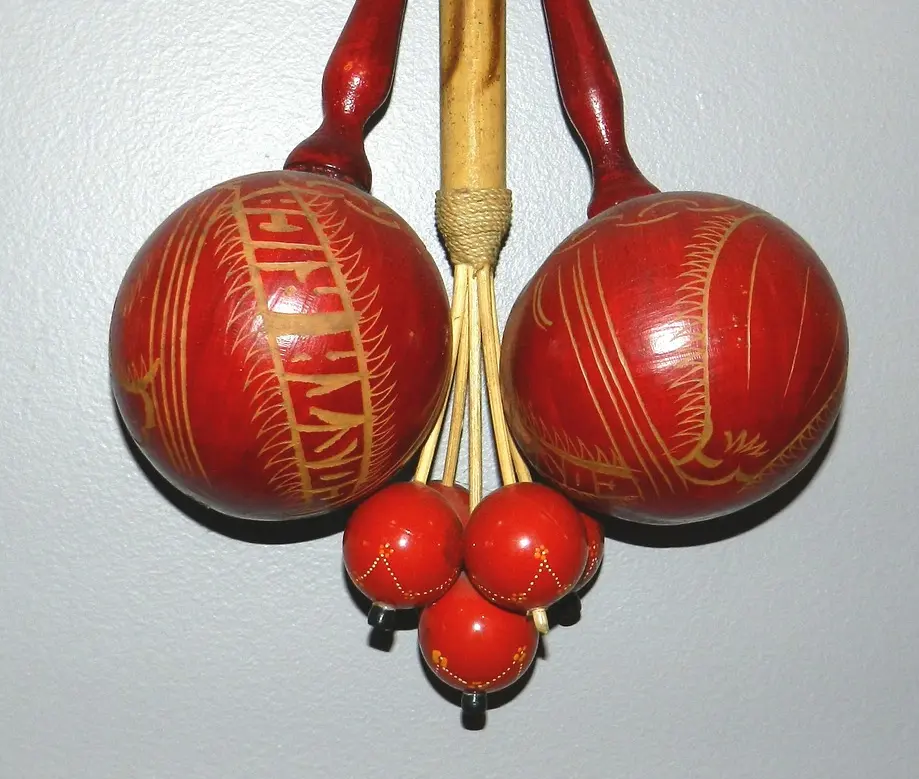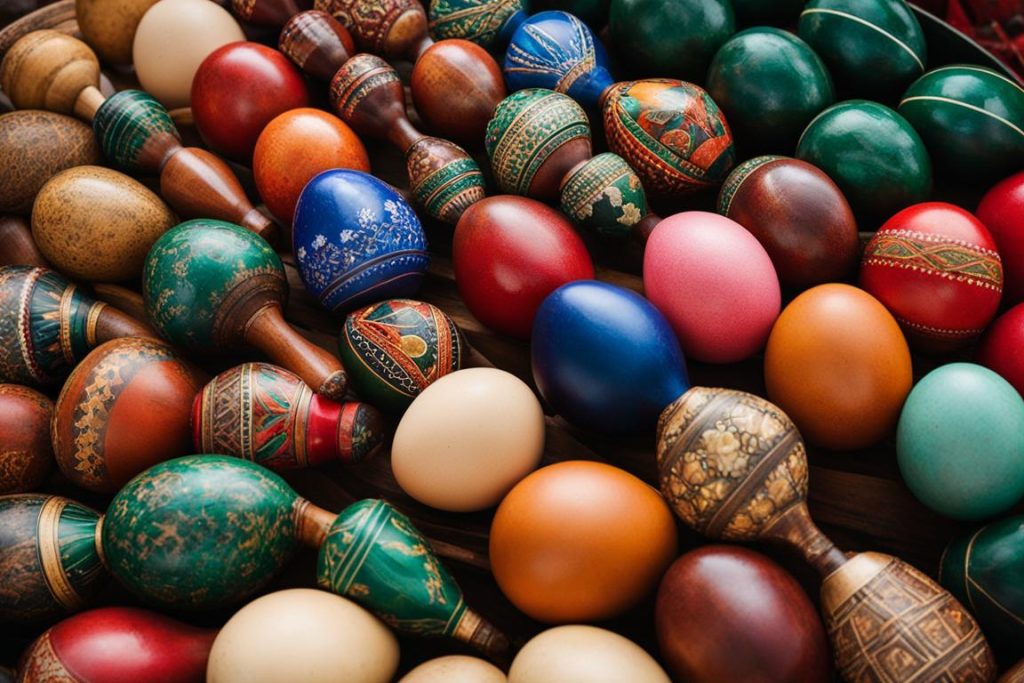When it comes to creating musical sounds and rhythms, shaker instruments like maracas and egg shakers play an important role.
These percussion instruments are commonly used in various musical genres to add texture and rhythmic elements.
While maracas and egg shakers may appear similar at first glance, there are distinct distinctions between the two. Let’s find out what’s the difference between maracas and egg shakers.

Maracas, with their origins in Latin American music, have a long history and are often made with a hollow gourd or wooden shell filled with seeds or beads.
They produce a louder and more traditional percussive sound, making them a staple in samba groups, mariachi bands, and other ensembles.
On the other hand, egg shakers are smaller and have a more versatile nature. They are typically made with plastic molds in the shape of an egg, filled with metal beads or seeds.
Egg shakers produce a softer and more subtle shake, making them suitable for creating a gentle percussive effect in various musical settings.
So, whether you’re looking for the authentic and vibrant sound of maracas or the versatility of egg shakers, understanding the construction, sound, and cultural associations of these percussion instruments can help you make an informed choice for your musical journey.
Content
Construction of Maracas and Egg Shakers
Maracas and egg shakers are percussion instruments that produce sound when shaken. Understanding the construction of these instruments can provide insight into the unique sounds they create.
Maracas are typically constructed using a hollow gourd or wooden shell. The shell is filled with materials such as seeds, beads, or other small objects to produce the desired sound.
The colorful decorations and patterns on the shell add visual appeal to the instrument.
Egg shakers, on the other hand, are made using plastic molds in the shape of an egg. These molds consist of two halves that can be filled with small metal beads or seeds. The plastic shell comes in a variety of colors, making them visually attractive.
The filling of both maracas and egg shakers plays a crucial role in sound production. When shaken, the filling creates vibrations that generate the percussive sound associated with these instruments.
The specific materials used in the construction, as well as the amount and size of the filling, contribute to the distinct sound produced by each instrument.
Comparison of Maracas and Egg Shakers Construction
| Instrument | Construction | Filling | Materials |
|---|---|---|---|
| Maracas | Hollow gourd or wooden shell | Seeds, beads, or small objects | Gourd, wood, seeds, beads |
| Egg Shakers | Plastic mold in the shape of an egg | Metal beads or seeds | Plastic, metal, seeds |
Playing Styles and Sound of Maracas and Egg Shakers
Maracas and egg shakers offer different playing styles and produce distinct sounds, making them versatile percussion instruments in various musical settings.
Maracas can be played in different ways to create a range of rhythmic patterns. They can be shaken up and down to produce a fast and lively percussion line, adding energy and intensity to the music.
Alternatively, maracas can be shaken from side to side, resulting in a slightly different sound that adds depth to the rhythm. These playing styles make maracas suitable for a variety of musical genres, including Latin American music, samba groups, and mariachi bands.
Maracas are often played alongside other instruments like drums, piano, saxophone, and bass guitar, enhancing the overall musical experience.
Egg shakers, on the other hand, offer a softer and more subtle shake compared to maracas. They can be played in different ways depending on the desired effect. You can gently shake them in a back-and-forth motion to create a delicate percussive sound, perfect for creating a gentle rhythmic pattern.
The versatility of egg shakers allows them to be used in various musical settings, ranging from children’s music classes to professional performances.
They are particularly popular in early music education, where children can explore rhythm and develop their motor skills.
The sound differences between maracas and egg shakers can be attributed to their construction, filling, and playing styles.
Maracas, with their larger size and use of seeds or beads, produce a louder and more traditional percussive sound. On the other hand, egg shakers, with their smaller size and use of metal beads or seeds, produce a softer and more subtle shake.
These differences in sound allow musicians to create different textures and moods in their music, adding depth and variety to their performances.
| Maracas | Egg Shakers |
|---|---|
| Shaken up and down to create a fast and rhythmic percussion line | Gently shaken in a back-and-forth motion to create a gentle percussive effect |
| Shaken from side to side to produce a slightly different sound | |
| Often played alongside other instruments | Versatile instrument suitable for various musical settings |
| Commonly used in early music education | |
| Produces a louder and more traditional percussive sound | Produces a softer and more subtle shake |
Availability and Cost of Maracas and Egg Shakers

Maracas and egg shakers are readily available in most music shops, making it convenient for you to find these percussion instruments.
Whether you’re a beginner or an experienced musician, you’ll be able to find a wide variety of maracas and egg shakers to suit your preferences.
When it comes to availability, both maracas and egg shakers come in a range of colors, sizes, and designs.
Maracas, being traditional instruments with a rich history, offer a wider selection of options and often come in pairs. This allows you to explore different styles and sounds when playing with maracas.
The cost of maracas can vary depending on factors such as the material used, craftsmanship, and brand. High-quality maracas made from exotic woods or premium materials may have a higher price tag.
However, you can also find reasonably priced maracas that deliver excellent sound and durability without breaking the bank.
On the other hand, egg shakers are known for their affordability. They are often sold in packets alongside other similar percussion instruments like tambourines and finger cymbals.
The use of inexpensive materials like plastic and seeds contributes to the lower cost of egg shakers. This makes them a great option for those on a budget or for kids who want to explore music without a significant financial commitment.
Homemade Maracas
Create your musical instruments with these homemade egg shakers and maracas! This fun craft project is perfect for both children and adults and provides an opportunity to explore creativity and experiment with sound.
By using simple materials that can be found at home or purchased at craft stores, you can make your very own percussion instruments.
Craft Your Homemade Maracas
If you prefer the sound of maracas, you can easily make your own at home as well. To start, find plastic spoons and plastic eggs.
Attach the spoons to the eggs using tape or strong adhesive, creating handles for your maracas. Make sure the spoons are securely attached to ensure they won’t come loose during use.
Just like with the homemade egg shakers, you can fill the maracas with various materials to create different sounds.
Experiment with different fillers, such as rice, beans, small pebbles, or even tiny bells. Play around with the amount of filling to achieve the desired sound and shake level.
Once your homemade maracas are complete, give them a shake and enjoy the rhythmic sound they produce. Homemade maracas are great for adding flair to music performances, dance parties, or even as props for theatrical productions.
Whether you choose to make homemade egg shakers or maracas, this DIY project is a fantastic way to express your creativity and explore the world of music-making.
It’s a cost-effective way to enhance your rhythm exploration and create personalized percussion instruments.
Now that you now what are the difference between maracas and egg shakers, you can choose the instrument that best suits your musical needs and preferences.
